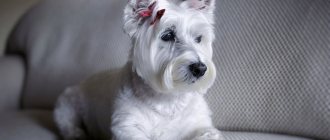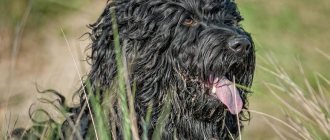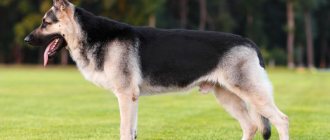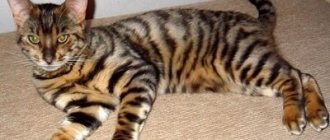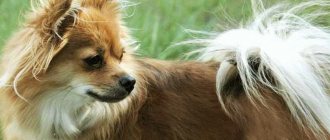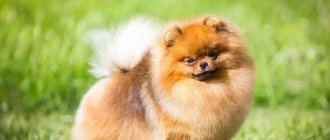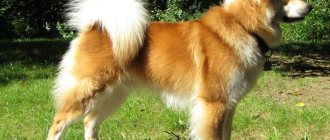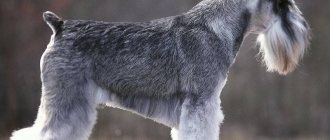What does a chow chow look like in the photo?
A correctly built dog with a rather massive, square body.
They have a majestic posture and a proud disposition . Despite the fact that Chow Chows are loyal to their owners, they are quite restrained in expressing their feelings.
They do not like noise and fuss and behave with the dignity of true aristocrats: their movements are calm and measured, and their gaze is full of grandeur.
The most characteristic breed characteristics of the Chow Chow include an unusually dense and thick coat, forming a thick collar around the animal’s neck, reminiscent of a lion’s mane, as well as a dark blue tongue .
Training and care
The animal is famous for its serious, domineering and stubborn disposition. In most cases, it can be difficult for an inexperienced dog breeder to cope with a dog with such a character. Most often, professional help in training a Chow Chow is required. It is important to do this from the very first months.
As for the owner, it is important to be patient and persistent. If the owner is calm and balanced, the pet will be the same.
In addition, chow chows are prone to laziness, therefore, it is necessary to gently but persistently accustom your pet to a sufficient amount of physical activity from early childhood.
The animal has an increased level of anxiety and distrust, so from the first months the pet must see guests, neighbors and children. Socialization for dogs of this breed is very important.
A pet can be kept not only in a private home, but also in an apartment, if its area allows.
The animal is famous for its serious, domineering and stubborn disposition.
Due to its dense coat, especially in summer, the Chow Chow must be protected from overheating and direct sunlight.
The animal's nutrition must be complete and balanced. The dog should receive all the necessary vitamins and minerals from food. Otherwise, the shortage will affect, first of all, the quality of the coat, and then the health of the pet. You can feed your dog good ready-made food, choose luxury and premium brands. If you decide to cook your own food, then remember that your diet should include cereals, meat, fish, vegetables and fruits.
Breed standard
The Chow Chow's head is quite large, but at the same time proportionate to the body.
The skull is wide and rather flat; the transition from the forehead to the muzzle, which is evenly wide along the entire length, is not sharp.
- The jaws are strong and strong, the bite is regular, scissor-shaped.
- The ears are erect, medium-sized, thick and dense, with slightly rounded ends.
- The eyes are oval, relatively small and dark.
- The neck is of medium length, voluminous and strong.
- The withers are pronounced, the back is level, straight and rather short. The chest is deep and moderately wide, with rounded ribs. The stomach is slightly tucked.
- The tail, lying tightly on the back and set quite high, is abundantly covered with grooming hair.
- The forelimbs are straight and strong.
- Hind limbs with well-developed and voluminous muscles on the thighs and minimal articulation angles. The hocks and metatarsals are directed vertically downward, due to which the dog moves with a kind of “stilted” gait.
Due to the fact that the ears are directed forward and slightly brought together, a gloomy and serious expression is created, typical of the Chow Chow..
History of the Chow Chow breed
White Chow Chow
Today there is no reliable information about when exactly the history of the Chow Chow began. But the fact that it dates back several thousand years is beyond doubt. According to some data, back in the 3rd millennium BC. e. in the palace library of the Chinese emperors there were records about this amazing breed, which, unfortunately, have not survived to this day.
One version of the origin of the breed says that the first dogs of this type appeared in China as “gifts of peace” that the Mongol conquerors presented to the emperor. The bear dog came to the Mongols as a military trophy during clashes with the indigenous peoples of Siberia. Archaeological finds confirm that the ancestors of the Chow Chow lived in this territory.
The question of the genetic roots of the representatives of the breed remains open to this day. Many experts are inclined to accept the version about the origin of the chow chow from polar wolves. The fashionable legend that the first dogs of this breed appeared as a result of an interspecific crossing of a husky and a polar bear does not stand up to criticism.
Once in China, Chow Chows were initially the property of only the courts of high-ranking nobles. But gradually interest in animals faded away, and dogs spread throughout the country, they could even be found in the homes of poor Chinese. Control over the purity of blood was lost. The situation was saved by the monks of Buddhist monasteries in Tibet, Manchuria and Northern China, who carried out careful selection work and kept pedigrees of blue and black chow chows.
Europe greeted the “bear” dog as a strange beast from the distant Celestial Empire. The first “fluffies” appeared here in 1780 and for almost a hundred years they were perceived only as exotic animals. The situation changed in 1865, when Queen Victoria, fascinated by the plush miracle given to her, showed interest in the breed. In 1887, the British began breeding Chow Chows, and eight years later the breed standard was approved and the first Chow Chow Club appeared in the Old World.
The Russian history of the breed goes back about eighty years, when the animals appeared in the Soviet Far East. Later, after 1945, some of the dogs were brought to the USSR from the eastern regions of Germany. A more or less stable population was formed only in the 60s of the last century. It became possible to get closer to world quality standards for the breed only after 1976, when purebred Chow Chows from recognized and titled producers were brought to the Leningrad Kennel Club.
Chow-chow female and male
Chow chow puppies
Briefly about character and temperament
Chow-chows are calm and almost imperturbable dogs, which are characterized by such character traits as affection for the owner and distrust of strangers.
They are not naturally aggressive; they are quite friendly and phlegmatic animals. However, this does not prevent these dogs from being excellent guards.
IMPORTANT!
Chow Chows tend to become attached to only one owner.
Their early education is of paramount importance, since if by adolescence the Chow Chow does not choose the main owner in the family, then she may refuse to obey and recognize someone’s authority in the house.
These are quite independent and freedom-loving dogs who have their own outlook on life, sometimes not coinciding with the worldview of their owners..
Sometimes they can be incredibly stubborn and refuse to follow commands.
Chow Chows can be markedly distrustful of strangers and are not very friendly towards other people's pets.
They treat children kindly, but at the same time rather indifferently.
Character
Only a strong, confident person with training skills can get a Chow Chow puppy. The animal is very independent and distrustful. In order for these characteristics of the breed to be less pronounced, a Chow Chow puppy must be socialized from early childhood.
Chow chows exhibit excellent guard qualities, which is worth considering when guests arrive in your home. A well-mannered dog is not aggressive, but will always be on guard.
Dogs of this breed are prone to laziness. For normal physical and intellectual development of the pet, owners must provide adequate daily physical activity. It is advisable to take walks in the morning and evening, and they should last at least an hour.
Owners of representatives of this breed need to think through a range of activities, since the dog is quite smart and may resist performing the same movements.
Stubbornness and willfulness - these traits are present in the character of the animal. Usually they choose one favorite from all family members and listen to him most of all.
Chow chows show excellent guard qualities. As for the joint breeding of dogs of both sexes, it is difficult to predict their behavior. Usually they behave quite tolerantly, but there may be nuances.
Dogs do not like other pets and small children. They are considered noble because of their special love for cleanliness and their reluctance to walk on wet grass or in the rain.
Popular types and their descriptions
- Long-haired . The coat of these dogs is completely straight, long, thick and dense, forming a mane or a kind of collar on the neck and feathering on the hind legs. The guard hair is strong and rather coarse, while the undercoat, on the contrary, is soft and fluffy.
- Shorthair (smooth). The coat is straight, short and dense, as if stuffed. The texture and density resembles plush with long pile.
A feature of both long-haired and short-haired Chow Chows is the vertically growing coat that does not lie close to the body.
Varieties by size
There are two size varieties of this breed:
- Standard . The height of males ranges from 48 to 56 cm and weighs 25-32 kg. Bitches are slightly smaller: their height at the withers is 46-51 cm, and their weight is from 20 to 27 kg.
- Mini. The height and weight of these dogs is less than that of standard dogs. On average, a male mini chow chow has a height of 37-40 cm, and a female - from 35 to 38. Minimum weight and height are not indicated, but a height of less than 30 cm for a mini chow chow is considered not very desirable.
The miniature variety of Chow Chow is not recognized by the standard: such dogs are not allowed for exhibitions or for breeding.
Advantages and disadvantages
Pros:
- Original, lion-like appearance.
- Balanced temperament.
- Friendly and non-conflicting towards other people's dogs.
- Loyal to their owners.
- Great for city living.
- They do not need much physical activity or long walks.
- They guard the apartment quite well, but they don’t bark at every sound.
- They do not have the bad habit of chewing furniture or tearing wallpaper off the walls.
- Very clean and tidy.
Minuses:
- Despite their devotion to their owners, they prefer to be somewhat independent.
- Sometimes they are stubborn and do not want to obey their owners.
- They are rather indifferent towards small children.
- Subject to frequent mood swings.
- They do not like other pets if they do not know them from an early age.
IMPORTANT!
Mini Chow Chows should be handled strictly but respectfully.
These dogs cannot tolerate rude and unfair treatment, in which case they become stubborn, self-willed and can even take offense for a long time.
Main types of colors
Black
The most preferred is pure black without any extraneous shades. However, most Chow Chows of this color have lighter fur on the hind legs and tail.
Blue
It can be any gray-bluish shade: from light steel to dark lead.
Cinnamon
A brownish tint, from almost sandy to a diluted coffee-au-lait color, but always with a cool grayish-silver sheen.
Ginger
It can be either almost fawn or bright, rich red.
Cream
Cream Chow Chows are usually a pale golden or very light fawn color. But the palette of this color is much wider: it covers all shades from almost white to light caramel.
Grey
In fact, this is one of the variants of the blue color, in which sometimes there is a warmish sheen to the coat, which is why it does not look bluish, but rather gray or silver.
White
Pure white color, especially if it is associated with albinism, is considered a defect in the breed. But white in combination with yellowish or pale apricot darkening on the ears is considered a variant of the cream color and is not a plembrac.
The “panda” color popular on the Internet does not exist among chow chows: these are ordinary light cream dogs, whose fur has been artificially dyed black in places..
Boys and girls: how are they different?
Male Chow Chows are larger and more massive than females . They are more muscular and compact in build.
Also, boys of this breed have a larger and more voluminous head, and a wider muzzle.
The coat of males is thicker and longer than that of females, and the mane and fringe are more pronounced.
History of the origin of the breed
Surprisingly, the cute and loyal Chow Chows are descendants of wolves that lived in the steppes of Ancient China. For a long time they were used as guards and hunters.
Only in the 19th century did Europeans learn about them, and they began to keep them as pets.
What puppies look like (photos)
Below is a description of what Chow Chow puppies look like by month.
1 month
The puppies look well-fed, but not overfed.
They have a rather squat body, short thick paws, rather large heads with a slightly convex skull, short voluminous muzzles and small dense ears still pressed to the head.
The coat of babies is soft and even of long-haired puppies is short and plush . The eyes may retain a slight bluish tint, but the look is already serious and slightly frowning.
2 months
By this age, the coat of long-haired puppies noticeably lengthens, and the ears are slightly raised at the base.
The muzzles of two-month-old Chow Chows look a little longer than before, but the overall “plush” appearance is still retained.
3 months
Three-month-old puppies begin to develop hair in the form of a collar or mane. Their fur is now quite long and thick. The ears no longer sag, but stand up, although perhaps not quite vertically.
At the same time, puppies still look plump because they do not yet have the well-developed muscles characteristic of adult dogs.
4 months
By four months, the Chow Chow's legs and muzzle begin to lengthen.
At this age, they already have fairly long hair, forming a clearly visible mane and collar.
5 months
The little Chow Chow's coat lengthens even further and becomes thicker and denser.
She is no longer as plush as before, but by this age the puppy already has a fairly long mane and feathers on the tail and limbs.
The muzzle becomes longer and not as voluminous as before.
6 months
At six months, the body proportions of a growing chow chow become similar to adults. The legs lengthen so much that the body becomes almost square. Due to the onset of shedding, the fur looks so thick, and the mane and tail feathers become less fluffy.
7 months
Shedding continues, which is why the puppy's coat looks a little patchy and uneven in color.
However, by this age the mane again becomes well defined, and feathering again appears on the hind legs . Body proportions are already close to those of adult dogs.
8-9 months
The puppy is still shedding, and by this age the baby hair has almost completely come out, and the adult hair grows somewhat unevenly, which is why in some places, for example, on the back of the front paws, sparse fringes are formed that look like feathers.
By this age, many young Chow Chows have almost reached their maximum size, but continue to gain muscle mass and weight..
10 months
The molt is completely completed or is nearing its end and by this age the young Chow Chow finally acquires a truly long and thick mane and a fluffy tail.
The hair on the body also lengthens, although it does not yet reach its maximum length . The head and muzzle increase in volume and become more massive.
11-12 months
By this age, the Chow Chow has almost completely grown and the proportions of its body finally acquire the appearance typical for the breed. By this time, he has a long and lush mane, as well as feathering on the tail and hind limbs.
But the hair on the body is still short, it will grow later and reach its final length by about three years of age.
In the period from four to six to seven months, the puppy grows unevenly, but as if in parts, which is why the proportions and sizes of its body, paws and head are constantly changing.
How to choose?
People who want to buy a Chow Chow should not rush to buy a dog. First, you need to decide on the gender and color of your future pet.
Bitches have a softer character and are less likely to be stubborn than males . But boys of this breed look more impressive, and therefore future owners who want to successfully exhibit their pets should think about purchasing a male dog.
A girl is better suited as a family dog, since the innate maternal instinct makes bitches more favorable not only to puppies, but also to small children.
You need to purchase a dog through a club or kennel.
However, when choosing a nursery on your own, you need to remember that some of them are not included in the RKF, and, therefore, a chow chow purchased there cannot be shown at all exhibitions, including international ones.
NOTE!
Buying a dog on the market and without documents of origin is fraught with the risk of purchasing not a chow chow at all, but a mixed breed or a mongrel puppy.
When choosing a future pet, you need to remember that it must be healthy, well-fed and moderately mobile. Excessive slowness, as well as excessive fussiness, can be signs of a not very good psyche.
The color of a small Chow Chow can differ noticeably from the color of an adult dog, so, first of all, you need to focus on what the parents of the chosen baby look like.
After all, the puppy will most likely inherit the color from one of them, and not from a more distant ancestor.
Character of the Chow Chow
- The Chow Chow's lack of a sense of humor and the need for fun games with humans is one of the striking qualities of these animals.
- Independence and a serious attitude towards everything can discourage an inexperienced owner, but in fact, dogs of this breed, like fighting dogs , are ready to give their lives protecting their owner.
- Even small puppies, charming and clumsy like all babies, do not like invasion of personal space and can be brought to a boil, trying to bring any of their ideas to life.
- Communication with a Chow Chow requires the owner to have endless patience and respect for the interests of the dog; only then does a calm, well-mannered dog grow out of a stubborn, aggressive animal.
- Pets living in the same territory as dogs of this breed are usually perceived by them calmly, and any stranger can cause an outburst of uncontrollable rage. That is why, when meeting or communicating with dogs or cats unfamiliar to the dog, the owner must put him on a leash and control his behavior.
- The tendency to dominate in the family is often found in dogs of this breed, and it begins quite early, even in puppyhood. As in the case of the Alabai , the owner must firmly suppress the Chow Chow’s attempts to impose its will, otherwise it will be very difficult to cope with an adult gloomy dog.
Important: Chow Chows grow and mature very quickly, so you shouldn’t delay socializing and training your puppy!
Chow Chows prefer passive walks
